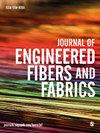Recent advances in piezoelectric textile materials: A brief literature review
IF 2.3
4区 工程技术
Q1 MATERIALS SCIENCE, TEXTILES
引用次数: 0
Abstract
Smart textiles (ST) can be defined as materials capable of detecting an external stimulus, responding, and adapting its behavior according to the stimulus obtained. The field of study and development of these materials is extensive, and ST can be seen in areas such as health, transport, security, civil construction, and sports. Piezoelectric textiles are part of the ST category and are characterized due the ability to generate electrical energy from mechanical stimulus, and vice versa. Therefore, the main objective of this review is to present the current research on piezoelectric ST. In addition, the study highlights the process of obtaining materials with piezoelectric properties and the challenges and limitations, seeking to understand the contribution of the development of these materials in the field of wearable electronic devices. Thus, the main challenge in developing piezoelectric textiles is in the ability to supply energy to electronic devices to be applied in various fields such as motion detection, acoustics, impact absorption, among others. Moreover, piezoelectric ST is remarkably promising for the development of wearable electronic textiles (e-textiles) that consequently impact the creation of new functional materials that enable renewable sources to offer a positive contribution in the daily society.压电纺织材料的最新进展:文献综述
智能纺织品(ST)可以定义为能够检测外部刺激、做出反应并根据获得的刺激调整其行为的材料。这些材料的研究和开发领域非常广泛,在卫生、交通、安全、土木建筑和体育等领域都可以看到ST。压电纺织品属于ST类,其特点是能够从机械刺激中产生电能,反之亦然。因此,本综述的主要目的是介绍压电ST的研究现状。此外,本研究强调了获得具有压电性能的材料的过程以及挑战和局限性,试图了解这些材料在可穿戴电子设备领域的发展贡献。因此,开发压电纺织品的主要挑战在于向应用于各种领域的电子设备提供能量的能力,例如运动检测、声学、冲击吸收等。此外,压电ST在可穿戴电子纺织品(电子纺织品)的开发方面非常有前景,从而影响新功能材料的开发,使可再生能源能够在日常社会中做出积极贡献。
本文章由计算机程序翻译,如有差异,请以英文原文为准。
求助全文
约1分钟内获得全文
求助全文
来源期刊

Journal of Engineered Fibers and Fabrics
工程技术-材料科学:纺织
CiteScore
5.00
自引率
6.90%
发文量
41
审稿时长
4 months
期刊介绍:
Journal of Engineered Fibers and Fabrics is a peer-reviewed, open access journal which aims to facilitate the rapid and wide dissemination of research in the engineering of textiles, clothing and fiber based structures.
 求助内容:
求助内容: 应助结果提醒方式:
应助结果提醒方式:


